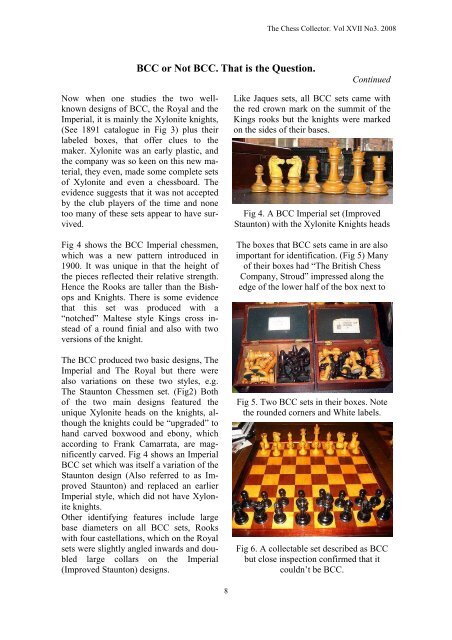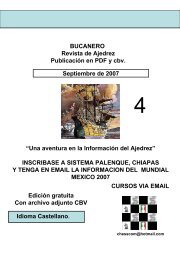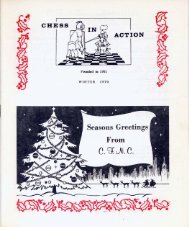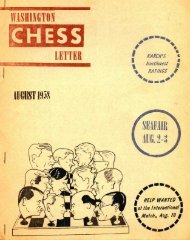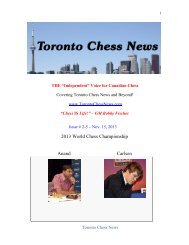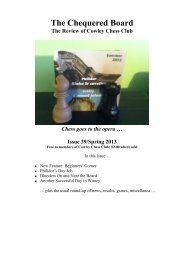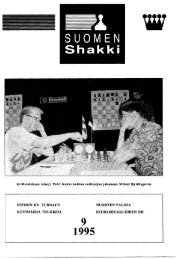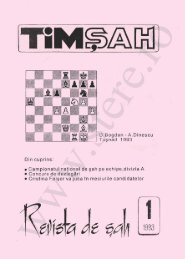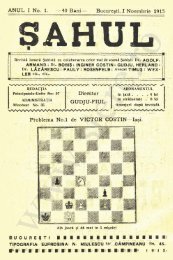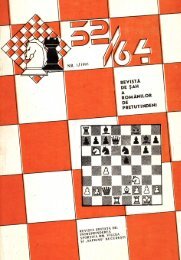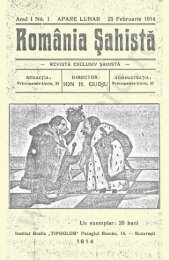The Chess Collector
El ajedrez es un juego, considerado un deporte, entre dos personas, cada una de las cuales dispone de 16 piezas móviles que se colocan sobre un tablero dividido en 64 escaques. En su versión de competición está considerado como un deporte.
El ajedrez es un juego, considerado un deporte, entre dos personas, cada una de las cuales dispone de 16 piezas móviles que se colocan sobre un tablero dividido en 64 escaques. En su versión de competición está considerado como un deporte.
Create successful ePaper yourself
Turn your PDF publications into a flip-book with our unique Google optimized e-Paper software.
<strong>The</strong> <strong>Chess</strong> <strong>Collector</strong>. Vol XVII No3. 2008<br />
BCC or Not BCC. That is the Question.<br />
Continued<br />
Now when one studies the two wellknown<br />
designs of BCC, the Royal and the<br />
Imperial, it is mainly the Xylonite knights,<br />
(See 1891 catalogue in Fig 3) plus their<br />
labeled boxes, that offer clues to the<br />
maker. Xylonite was an early plastic, and<br />
the company was so keen on this new material,<br />
they even, made some complete sets<br />
of Xylonite and even a chessboard. <strong>The</strong><br />
evidence suggests that it was not accepted<br />
by the club players of the time and none<br />
too many of these sets appear to have survived.<br />
Fig 4 shows the BCC Imperial chessmen,<br />
which was a new pattern introduced in<br />
1900. It was unique in that the height of<br />
the pieces reflected their relative strength.<br />
Hence the Rooks are taller than the Bishops<br />
and Knights. <strong>The</strong>re is some evidence<br />
that this set was produced with a<br />
“notched” Maltese style Kings cross instead<br />
of a round finial and also with two<br />
versions of the knight.<br />
<strong>The</strong> BCC produced two basic designs, <strong>The</strong><br />
Imperial and <strong>The</strong> Royal but there were<br />
also variations on these two styles, e.g.<br />
<strong>The</strong> Staunton <strong>Chess</strong>men set. (Fig2) Both<br />
of the two main designs featured the<br />
unique Xylonite heads on the knights, although<br />
the knights could be “upgraded” to<br />
hand carved boxwood and ebony, which<br />
according to Frank Camarrata, are magnificently<br />
carved. Fig 4 shows an Imperial<br />
BCC set which was itself a variation of the<br />
Staunton design (Also referred to as Improved<br />
Staunton) and replaced an earlier<br />
Imperial style, which did not have Xylonite<br />
knights.<br />
Other identifying features include large<br />
base diameters on all BCC sets, Rooks<br />
with four castellations, which on the Royal<br />
sets were slightly angled inwards and doubled<br />
large collars on the Imperial<br />
(Improved Staunton) designs.<br />
Like Jaques sets, all BCC sets came with<br />
the red crown mark on the summit of the<br />
Kings rooks but the knights were marked<br />
on the sides of their bases.<br />
Fig 4. A BCC Imperial set (Improved<br />
Staunton) with the Xylonite Knights heads<br />
<strong>The</strong> boxes that BCC sets came in are also<br />
important for identification. (Fig 5) Many<br />
of their boxes had “<strong>The</strong> British <strong>Chess</strong><br />
Company, Stroud” impressed along the<br />
edge of the lower half of the box next to<br />
Fig 5. Two BCC sets in their boxes. Note<br />
the rounded corners and White labels.<br />
Fig 6. A collectable set described as BCC<br />
but close inspection confirmed that it<br />
couldn’t be BCC.<br />
8


